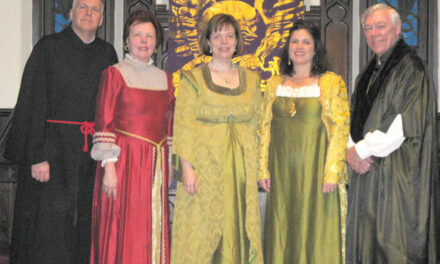The New Century Saxophone Quartet was founded three decades ago while its members were still students of the legendary James Houlik at the University of North Carolina School of the Arts. Judging by the outstanding performance in the charming Kulynych Auditorium in the Byrum Welcome Center of Wake Forest University and by the brisk post-concert sales of compact discs, the next three decades look promising indeed!
Although created by Adolph Sax in the 1840s, the saxophone didn’t find a broad following for a number of years, so we have no works by Wagner or Brahms or of their ilk, and it was not until the turn of the century that the instrument began to gain in popularity, particularly with the rise of jazz. The modern saxophone family includes an instrument for each voice of the quartet – soprano, alto, tenor and baritone. As a quartet, it is the most homogeneous musical ensemble I know of, except perhaps the string quartet and occasionally the barbershop quartet. Composers and arrangers take this uniformity of sound into account when writing for the saxophone quartet, for the sound is totally blended and does not have the options of color that one finds in the diversity of a woodwind quintet, brass ensemble or symphony orchestra. This said, the stupendous virtuosity and musicality of New Century sets them apart and turns their concert into a unique experience.
The concert was entitled “Weekend Travelers” and featured compositions inspired by folk music of various parts of the world, starting with a mariachi-inspired original composition by José Oliver Riojas (b. 1982) entitled “Veracruz”, a cheerful and frothy piece making great use of the Hispanic hemiola which comes from the alternation of 3/4 and 6/8 rhythms (see Bernstein’s “Ev‘ry-thing’s fine in A-me – ri – ca…”). The piece filled the hall and tested the mettle of the players, from the highest note possible to the very bottom of the register, and from a rare whisper to a volume reminding us that the saxophones are brass instruments!
The second work on the program was a spirited transcription by Dave Camwell (b. 1972) of the “Italian” Concerto by J.S. Bach. Hearing it legato and smooth with saxes instead of the instantly decaying sound of the keyboard, was like meeting an old friend in an unexpected and unusual situation – provocative and alluring. Adhering strictly to the score, the two outer movements gave us the very clearly defined counterpoint we expect. But the hasty tempo of the Adagio, which could have been a serene and expressive aria, caused the soprano sax to sound hurried as it scurried through its 32nd note passages.
Through oral program notes, we were happy to learn that the mystic Armenian philosopher, George Gurdjieff, had collected folk tunes of Southwest Asia, which in turn had been transformed into piano pieces by the Russian composer Thomas de Hartmann (1885-1956), several of which Ben Johnston (b. 1926) has arranged for sax quartet. These three colorful pieces allowed members of the quartet to take lengthy solos – first the baritone sax, played by Drew Hays in a lovely legato solo. Soprano saxophonist Michael Stephenson played the second solo that sounded almost like an oboe d’amore or an Armenian duduk. Again in the finale, Stephenson imitated the crude sound of the gypsy clarinet.
Two British-inspired movements from the Songs for the Weekend Traveler by David Cutler (b. 1971) brought the first half of the concert to a boisterous close with a hooting and screaming “Wedding Crasher.” The tribute to Anglo-Saxon folk music continued after intermission with three lovely tunes from the Robert Burns Suite by Paul Harvey (b. 1935), the second of which, “My Love is Like a Red, Red Rose,” begins many times anew with a solo, followed by a duet which revealed clearly sounding resultant tones. The third song, “Bannocks O’Bearmeal,” turned the lower three instruments into drones and the soprano saxophone into the chanter in an obvious and successful imitation of the Highland pipes. The British mode continued with “O Northern Star,” a lovely and well-written contrapuntal ballad by the group’s tenor saxophonist, Stephen Pollock.
The “Wedding Dance,” excerpted from the Hasseneh Symphonic Suite by Jacques Press (1903-1985) gave us a taste of Kletzmer style celebration. By contrast, the melancholic American folk song, “Oh Shenandoah,” was gentle and sad, fading out with the nostalgic… “Oh, Shenandoah, I long…”
Moving their music stands upstage, the quartet played the rest of the recital by memory. For their fast and fiery finale they played excerpts from the Folk Dances by Dmitri Shostakovich, again arranged by Riojas. This was played with almost reckless abandon, at a breakneck speed yet with the utmost precision of consummate virtuosity. The instant standing ovation brought on the most moving playing of the evening, a jazzy composition called “Gospel Fever” by Russell Peterson (b. 1969) which featured alto saxophonist Chris Hemingway in the most uplifting and energizing music I have heard in a long time! The audience vociferously showed its appreciation!











